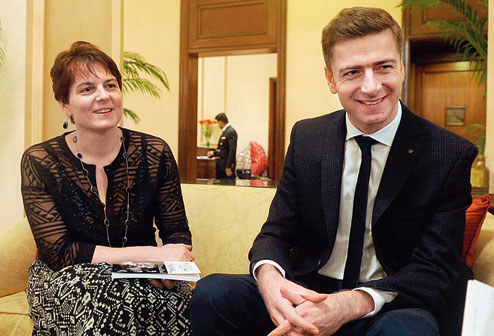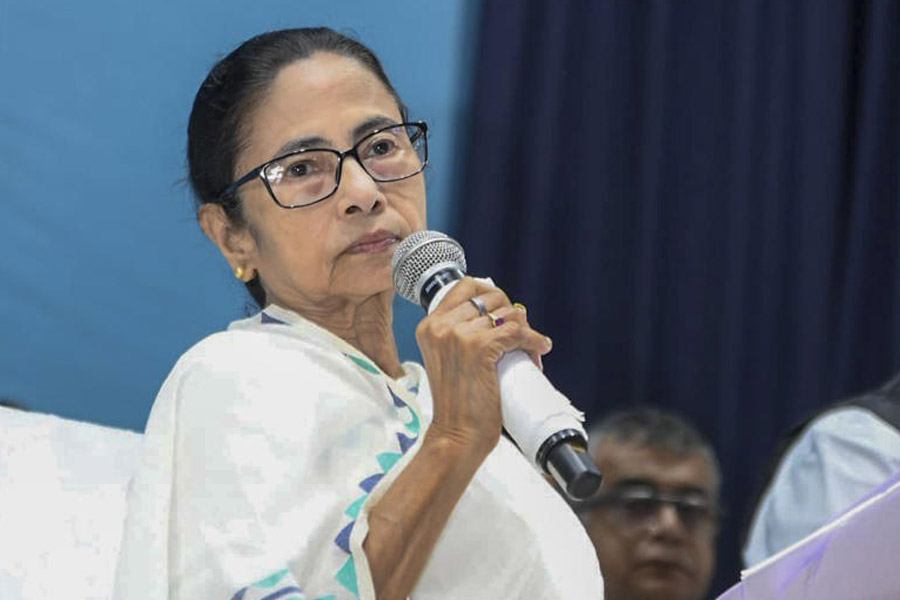

April 26: India and Lithuania may be observing the 25th year of diplomatic relationship but our bond with the Baltic nation goes back ages.
Lithuania speaks the closest extant sister language of Sanskrit. Thinkers and explorers have forged other links down the years. On their recent visit to Calcutta, Lithuanian ambassador Laimonas Talat-Kelpsa and senior diplomat Diana Mickeviciene unveiled two publications that put the spotlight on bilateral bonds.
The Lithuanian government has published a Sanskrit-Lithuanian dictionary containing 108 common words, many of which are startlingly similar. As Prime Minister Algirdas Butkevicius writes in the preface: "We say dievas (dev) when we appeal to God, labas (labh) when we greet each other wishing wealth and prosperity, and sapnas (sapna) when we share our dreams and visions."
"It is a wonder how when Sanskrit was petrified, Lithuanian retained so much of the conservative elements. Was it because it was the language of ordinary people like peasants who are conservative folks?" reflects Diana, whose Sanskrit teacher at Vilnius University, Vytis Vidunas, has done the compilation. Vidunas points out in the preface that the only work so far on the subject has been the 1968 book Balts and Aryans by linguist Suniti Kumar Chatterji.
The other book, sponsored by Lithuania's honorary consuls in Calcutta and Bangalore, has articles on three Lithuanian personalities and their links with India and Indians. Released by the ambassador in Calcutta, India & Lithuania: A Personal Bond, is a compilation of six papers presented at two conferences in 2013, in Delhi and Calcutta, along with one by Shimon Lev, an authority on Gandhiji's early years in South Africa.
"We pushed scholars in both countries to research on the connections. Our Prime Minister's visit to India in 2016 gave momentum to the projects," says the ambassador.
In search of links
When Lithuanian Radio was born in 1926, a welcome message was broadcast in nine languages. Antanas Poska, a young Esperanto speaker, was asked to read the message in Esperanto, an artificial language popular in parts of Europe in early 20th century. The radio got so many letters that Poska was asked to do a programme in Esperanto. "But when a caller from Sweden asked how Sanskrit was linked to Lithuania, Poska did not have an answer. That made him decide to travel to India to search for the link," said Diana. The 26-year-old set off on an 18-month epic bike ride.
Poska did his graduation in Bombay University and post-graduation in Calcutta University (CU). But he could not defend his doctoral dissertation as World War II broke out and he had to leave.
Metro has reported on the posthumous D.Litt that CU bestowed on the anthropologist in 2014.
"Poska was a friend of Chatterji, who visited him twice in Lithuania," points out Diana. "We have Chatterji's letters but have not been able to trace Poska's letters to him."
Poska had met Tagore and Gandhi twice. "He translated some of Tagore's work in Lithuanian and carried a table cloth gifted by Gandhi even to the Siberian camp where he was sentenced by the Soviets during their occupation of Lithuania. A wood carver's son, he carved spoons to make money to give as bribe to the guards for extra food. That's how he survived," said Diana.
Mahatma's soulmate
This element of do-it-yourself is also a powerful element in Gandhi's movement and could have been an influence on another Lithuanian. Hermann Kallenbach, a wealthy Jewish architect settled in South Africa, met Gandhi in 1903. "He gradually abandoned his riches and became not just his follower but also 'soulmates' with Gandhi," said Kelpsa.
"Kallenbach taught Gandhi to make chappals which later became iconic," Diana explained. He also set up Tolstoy Farm which became the headquarters for Gandhi's satyagraha movement. The two started for India together in 1913 but by the time the ship reached London, WWI had broken out and Kallenbach, a German passport-holder, was detained.
Lithuanian Gandhi
The third personality in the book, Wilhelm Storostas-Vydunas, never visited India or corresponded with Indians. "He was an armchair philosopher who read the Vedas and the Upanishads, translating parts to Lithuanian. You could call him a modern sage who did not care for degrees but wrote books and gave lectures. Another idea he preached was non-violent resistance." Though it was not identical to Gandhi's preachings, he was known as the Lithuanian Gandhi.
Research is throwing up more Lithuanians with India links. "We may have to do another project," the ambassador smiled.










